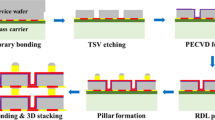Abstract
A low temperature direct bonding process with encapsulated metal interconnections was proposed. The process can be realized between silicon wafers or silicon and glass wafers. To establish well-insulated electric connection, sputtered aluminum film was patterned between a bottom thermal SiO2 and a top PE-SiO2; the consequential uneven wafer surface was planarized through a chemical mechanical polishing (CMP) step. Benefit from this smooth surface finish, direct bonding is achieved at room temperature, and a general yielding rate of more than 95% is obtained. Test results confirmed the reliability of the bonding. The main advantages of this new technology are its electric connectivity, low thermal stress and hermeticity. This process can be utilized for the packaging of micro electro mechanical system (MEMS) devices or the production of SOI wafers with pre-fabricated electrodes and wires.







Similar content being viewed by others
References
Shimbo M, Furukawa K, Fukuda K, Tanzawa K (1986) Silicon-to-silicon direct bonding method. J Appl Phys 60:2987–2989
Schmidt MA (1998) Wafer-to-wafer bonding for microstructure formation. Proc IEEE 86:1575–1585
Kovacs GTA, Maluf NI, Petersen KE (1998) Bulk micromachining of silicon. Proc IEEE 86:1536–1551
Takagi H, Maeda R, Suga T (1998) Low-temperature direct bonding of silicon and silicon dioxide by the surface activation method. Sensors Actuators A 70:164–170
Cozma A, Puers B (1995) Characterization of the electrostatic bonding of silicon and Pyrex glass. J Micromech Microeng 5:98–102
Lee TMH, Ming I-, Liaw CYN (2000) An improved anodic bonding process using pulsed voltage techniques. J MEMS 9:469–473
Wolffenbuttel RF, Wise KD (1994) Low-temperature silicon wafer-to-wafer bonding using gold at eutectic temperature. Sensors Actuators A 43:223–229
Oh KW, Han A, Ahn CH (2002) A low-temperature bonding technique using spin-on fluorocarbon polymers to assemble microsystems. J Micromech Microeng 12:187–191
Niklaus F, Enoksson P, Stemme G (2001) Low-temperature wafer-level transfer bonding. J MEMS 10:525–531
Cheng Y-T, Lin L, Najafi K (2001) A hermetic glass–silicon package formed using localized aluminum/silicon–glass bonding. J MEMS 10:392–399
Acknowledgements
The authors would like to thank the staff of Center for Microtechnologies in TU Chemnitz for their professional and dedicated service. Also special thanks to Sven Uhlig for bonding operation, and Ina Schubert for helpful discussion. The support of the colleagues of the Fraunhofer Institute of Reliability and Micro Integration (FhG-IZM) in Chemnitz is also acknowledged.
Author information
Authors and Affiliations
Corresponding author
Rights and permissions
About this article
Cite this article
Jia, C., Wiemer, M. & Gessner, T. Direct bonding with on-wafer metal interconnections. Microsyst Technol 12, 391–396 (2006). https://doi.org/10.1007/s00542-005-0034-6
Received:
Accepted:
Published:
Issue Date:
DOI: https://doi.org/10.1007/s00542-005-0034-6




